|
Africa
2024 Journal Pages:
1
2
3
4
5
6
7
8
9
10
11
12
January 14 continued
A
pair of ground hornbills waded ponderously through the tall grass.
They reminded me of the small stuffed-animal ground hornbill Paula
had purchased. Between us we actually had a small menagerie of
stuffed animals; besides my cheetah Duma, Paula had Tutu the
hornbill and a bushbaby named Merle, and Natalie had a wild dog
named Solo. Oh, and I had Samba the Mamba, my rubber snake – but
that is a story from another trip.
A pair of pygmy geese were swimming in a small lagoon. (I
am never sure what the difference is between a pygmy goose and a
duck!) A goliath heron stood with his neck arched into an S-shape;
they look similar to our great blue herons, but taller. We also
saw a reed cormorant and a rufous-bellied heron. Animals were a
little thin on the ground this morning, but we were seeing a
wealth of birdlife.
|
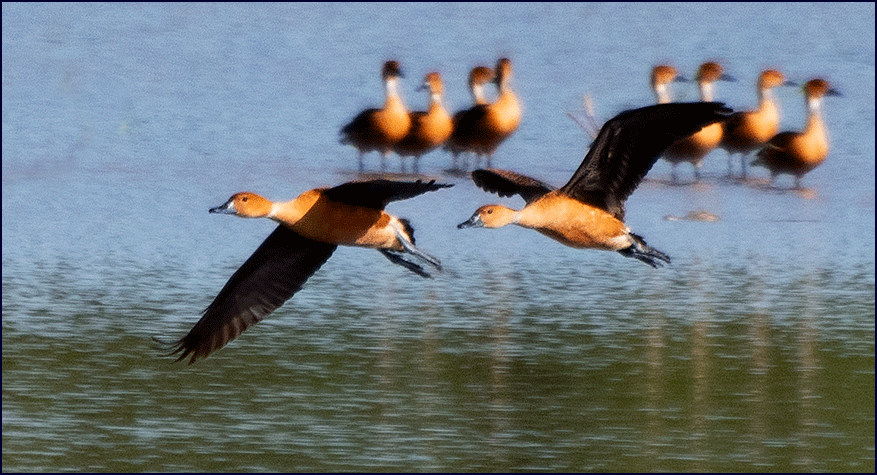
Fulvous ducks |
We went across an open plain of tall grass, dotted with a
few trees and many small channels. A fish eagle sat on a high
branch; these regal raptors are dark brown with white heads and
necks, and look very much like our bald eagles, though the white
extends down a bit further. They make a high-pitched piercing call
that sends shivers down your spine.
We came to a sausage tree, a lovely big shade tree with
large brown fruits hanging from the branches. These fruits are
said to resemble a large sausage, but they looked almost like a
baseball bat. Baboons eat them, as well as giraffes and elephants,
but they are not good for humans. Gee got out and picked a couple
of the fruits for us to examine; they weighed a ton. He also
showed us a pretty little pink flower he said was a viei ink
flower.
A gorgeous lilac-breasted roller posed for us on a crooked branch;
we were very close, and could see his multi-colored feathers and
the glint in his eye. We were having a food day for photogenic
birds!
|
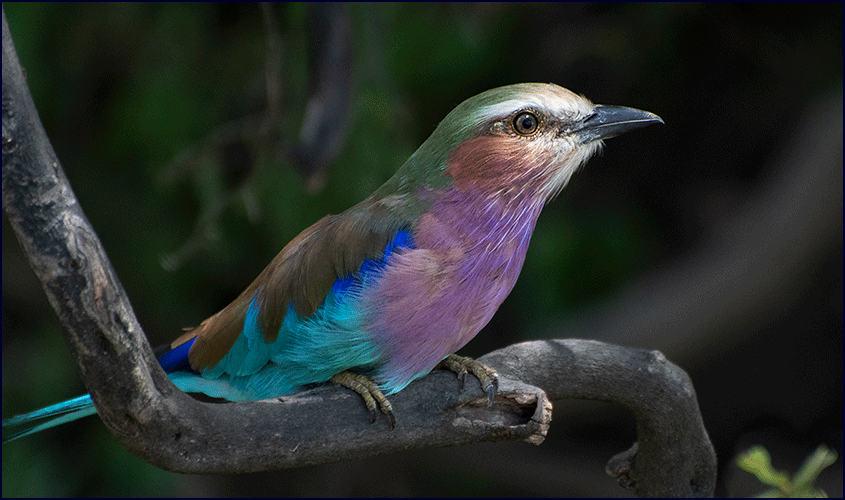
Lilac-breasted roller |
We went back to camp around noon for lunch. We told Gee
that they didn’t need to fix us any food for afternoon tea -
unless they were making another one of those lemon drizzle cakes!
We watched a pretty little black and yellow butterfly with purple
spots as it flitted around camp. We organized our belongings for
moving camp the next day, and had a little rest.
We headed out again at 3:30, back
to the wetlands. We added a green-backed heron and a beautiful
coppery-tailed coucal to our list.
An exquisite female kudu stood alone, close to road, gazing
at us benignly. We could just barely see the rest of her herd
blending in among the trees. An oxpecker sat on her neck, picking
at her ears. We were
close enough to see every detail of her feminine face, large ears
and big dark doe eyes. She had bands of dark and white across her
eyes and muzzle, and three white beauty spots on each cheek. She
had a scraggily mane like a horse, not only down her neck but all
the way across her back to her tail, and nine delicate white
stripes curved horizontally around her body. I am pretty sure she
was magic.
We drove along a sand road full of large puddles, and the
sound the tires made swooshing through the puddles sounded like
waves coming in on the beach. Janell dubbed it the Beach Road.
A small breeding herd of elephants lingered by the side of
the road, seven or eight of them, with a smallish baby about a
year old. One of the
youngsters, a couple years old, was missing half of his trunk;
probably from a crocodile, Gee said. What an awful thought. But he
seemed to be feeding himself OK without it, so we were hopeful
that he will be all right.
The moving clouds had been spectacular all day, and now
they were getting darker and more ominous. We passed a big lagoon
full of dead trees; a fish eagle perched in the top of one,
surveying his territory. Hippos floated in the pool. A black heron
crouched at the edge of the water, curving his wings like an
umbrella to shade the surface and fool the fish into seeking
shelter there. We came across a water thick-knee, an attractive
wading bird with long legs and big eyes. (I have always considered
thick-knee a rather poor name for a bird.) It flew away as we
approached with a call that sounded like a squealing pig.
The storm was upon us, and the rain was starting to blow.
We let down one side of the plastic siding on the land cruiser; I
didn’t like it when we had to put the sides down because then we
couldn’t see well. We watched a brilliant lightning display on
the horizon, but it must have been far away as we couldn’t hear
any thunder.
Hurrying
back under the darkening skies, we drove through some woods and
came across a big hippopotamus, glistening wet and moving faster
than you would expect. It was the closest we had been to one that
was not in the water. Impala made way before us.
A small family of zebras glowed gently in the semi-dark.
We made it back to camp around six, and had our usual
sundowner drinks around the table under the dining tent to avoid
the rain. We had goat for dinner; it is a common African dish, but
not my favorite. Gee walked Janell and I to our tent after dinner;
we were glad he had, as there was a hippo right out in front of
it, near the path. Gee quickly ushered us into the tent, and
returned to the dining area by another route, staying very close
to the tents.
It rained throughout the night. We
listened to the crazy snorting, grunting, laughing noises from the
hippos, who sounded very close to our tents.
January
15
It was travel day to Savuti, a
very game-rich area in Chobe National Park. The guys were packing
up the camp as we set out at six. Gee heard alarm calls from birds
and squirrels, and stopped to investigate. He said it was
something small, like a genet, owl or snake. Soon he found the
tracks of an African wildcat, and figured that was what the alarm
was about.
We paused to watch a hamerkop in a
puddle; soon another one joined him. I find them handsome birds,
and the males and females look just alike. We passed another pair
of wattled cranes; or perhaps it was the same pair again?
|
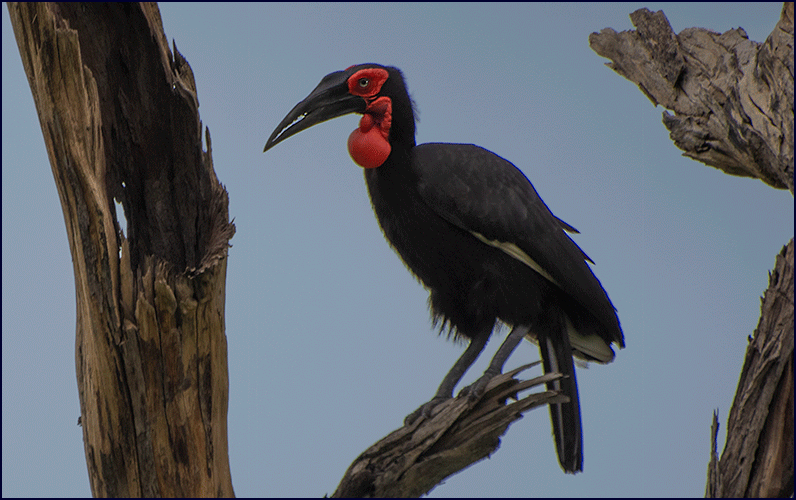
Ground hornbill
|
Two ground hornbills flew up to a big tree where they
appeared to have taken over a hamerkop nest; I hadn't realized
they could fly so well. They mated in the tree, with a lot of
squawking and flapping of wings. Following our custom of making up
bad limericks, I came up with this:
The
circle of life can be hit
or miss
It can be agony or sheer bliss
But for the ground hornbill
They found their thrill
Up a tree with the cloacal kiss.
A small herd of African buffalo grazed contentedly, though
the bull stared at us with a disgruntled expression when we went
by. Keep your distance, he no doubt was telling us.
We saw a pair of male waterbucks lying serenely in a
meadow. They have beautiful ridged horns that bend in a graceful
curve.
We came to the Khwai Gate about nine. Gee asked if we
wanted to have tea by the gate or just skip it, we said we would
skip it and just wait until lunch. He went in to register and we
got to use the Wi-Fi for a few minutes to check in at home. Gee
told us we could walk across the bridge; this is a rather
rickety-looking pole bridge over the Khwai River that leads into
Khwai village. It felt good to stretch our legs; the one thing
about a safari of this type is you don’t get a lot of exercise.
It was not terribly reassuring to see the holes and rotten timbers
in the bridge close up, covered only by pieces of thin rubber
mats, but both we and the vehicle made it across without incident.
|
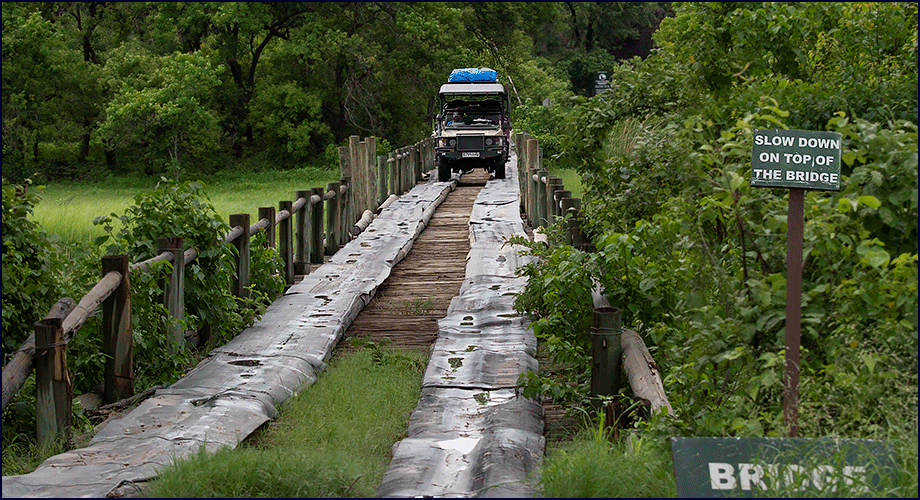
Khwai River bridge
|
We drove through the village, curiously watching the people
walking along the road, and looking at the small round houses,
many of them made with mud and thatch, but quite a few more modern
ones as well. Everyone we passed was very friendly, smiling and
waving to us. We saw many children, and several ladies with young
babies strapped to their backs.
Our camp staff truck, with the trailer and all our
equipment, caught up with us and went on ahead. (Gee told us they
had stopped at a store to buy a few supplies, especially toilet
paper, which apparently we had gone through faster than expected.)
|
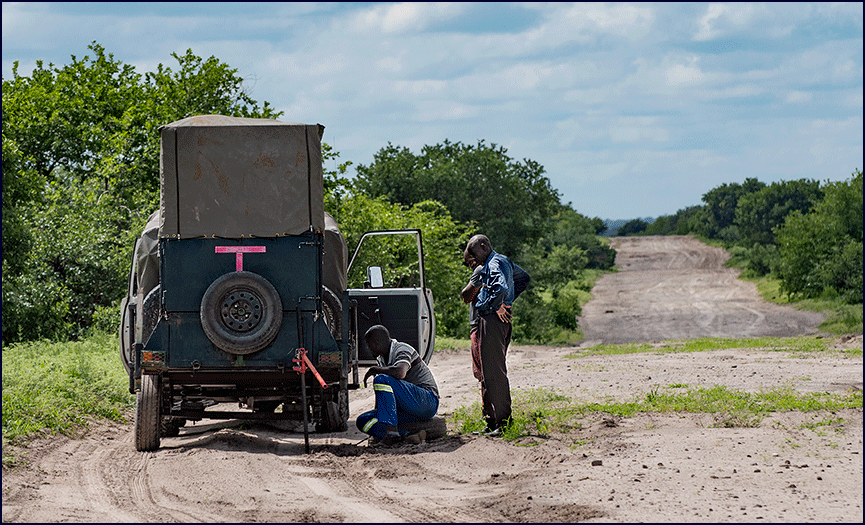
A
broken axel on the camp trailer.
|
We drove on the long, straight main road to Chobe; it was
washboarded sand with huge puddles - another Beach Road.
There was very little traffic. After about an hour we saw a
vehicle on the side of the road; to our dismay we realized it was
our crew. Were they changing a tire? Uh-oh, they had a broken axle
on the trailer. This was very bad.
Gee and the staff unloaded our luggage from the roof rack
and we took most of it inside with us in the seats. They took all
of the equipment from the trailer and managed to put it either on
the roof of our land cruiser or in the camp truck. The beds were
strapped to the top of our land cruiser; we were top-heavy for
sure, but they had managed to get everything in. We had to
temporarily abandon the trailer, and we continued on, the two
vehicles staying together now, both so full they were bursting at
the seams.
|
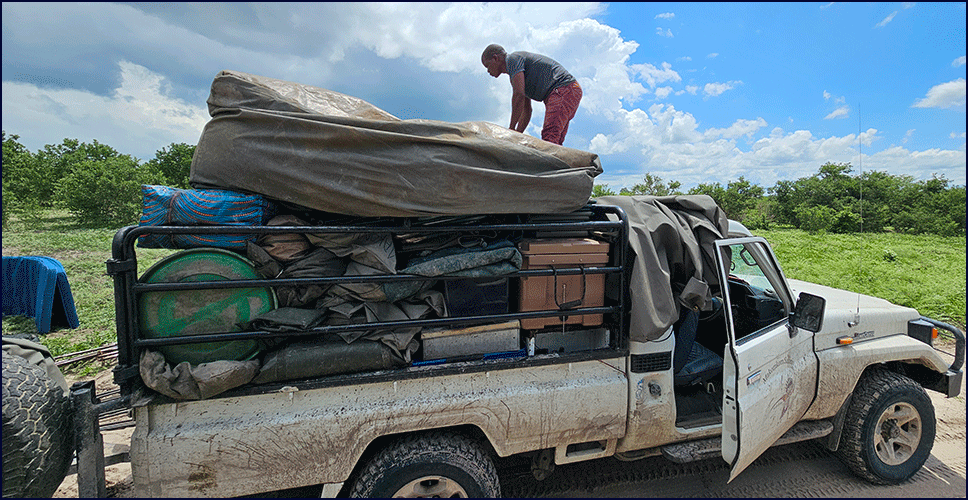
Loading up!
|
We reached the Mababe Gate shortly after 12.30.
While we waited for Gee to check in, we watched some plump
caterpillars crawling in a small mopane tree. They were black and
yellow, with bits of white and pale green. Mopane worms! Gee had
told us about them earlier; at times they are an important food
source for some of the local people. I was glad to get to see what
they looked like; I could imagine that if you fried them up, they
might not be too bad!
|
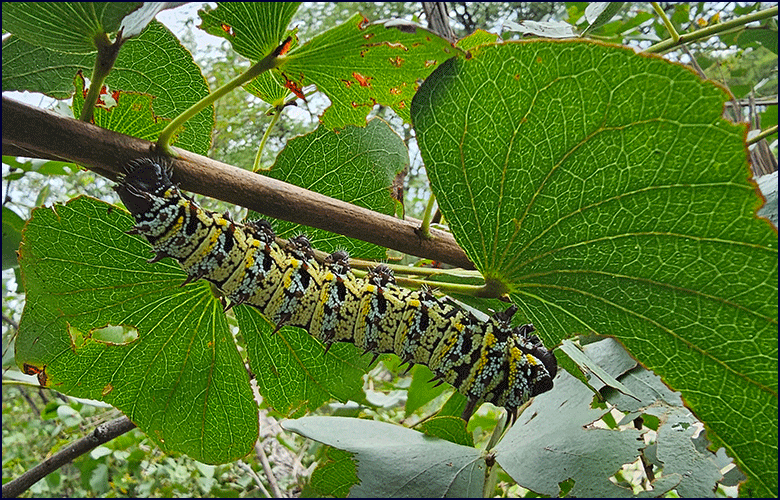
Mopane worm
|
Once we were past the Mababe Gate, the road became rougher.
There were many trees knocked down across the road by elephants;
to my surprise Gee told us the elephants blocked the road on
purpose if they were tired of the vehicles coming around. It
started raining lightly, but before long it was pouring. We put
all the flaps down but those in front were still getting drenched.
We couldn’t see much out the sides, and Gee could not see well
in front either. Large puddles covered most of the road, and some
concealed deep potholes. We crept along somewhat blindly.
Suddenly
there was a loud thump as the vehicles left rear tire went down
into a deep, steep-sided hole that had been made by the elephants.
Stuck again! I wondered if they had done it on purpose. The rain
was coming down in sheets. We all got out of the land cruiser
while Gee tried to drive it out, but the poor vehicle was loaded
way too heavy. Again, Gee got out the high-lift jack, while we
collected branches and wood. Soon we were all soaked and muddy,
especially poor Gee.
Finally, with much jacking up,
digging out and stuffing in of branches, Gee was able to rev the
engine and get the land cruiser to crawl up out of the hole. But
now the jack was wedged against the left fender and would not
release. Gee instructed us to stand back as he drove forward to
release the jack, and miraculously, it worked: he accelerated the
vehicle ahead with a lurch – right into another elephant hole!
Fortunately he was able to get out of this one quickly, and we all
climbed back in, wet and muddy, and drove on.
We followed the long road that crosses the Mababe
Depression, the bed of an ancient lake that existed 11,000 years
ago. Between stopping for the broken trailer axel and getting
stuck, we were now hours behind schedule. This was a problem
because we were required by the park to be in our new campsite by
6:30 pm, and at this rate we were cutting it pretty close. Mosa
had sent our lunch along, but now there was not time to stop and
eat it - we had to keep going. Darn, if we’d known, we
wouldn’t have skipped tea this morning! We passed around a few
snacks, but a little trail mix and a couple of Werthers candies
didn’t go too far.
Driving along the empty road, we entertained ourselves by
making up more murder mysteries and bad limericks. I can’t
remember exactly what the mystery was, but I remember Paula’s
guess as to the solution involved elephant farts, and we all
laughed long and hard. When I got home and looked at my notes
later, I found this little ditty:
Our
trip to Savuti had a bad start
With a broken axle on our cart
Then we got stuck
Deep in the muck
But our saving grace was elephant farts
Oh well, I guess you had to be there.
The Mababe Depression is a broad flat plain, dotted with
termite mounds. It is very beautiful. The woodlands were on our
left as we headed north, and we could just barely see a faint line
of trees to our right on the far side of plain, on the very edge
of the horizon. At first this open land seemed totally deserted.
But after a while we started seeing birds.
|
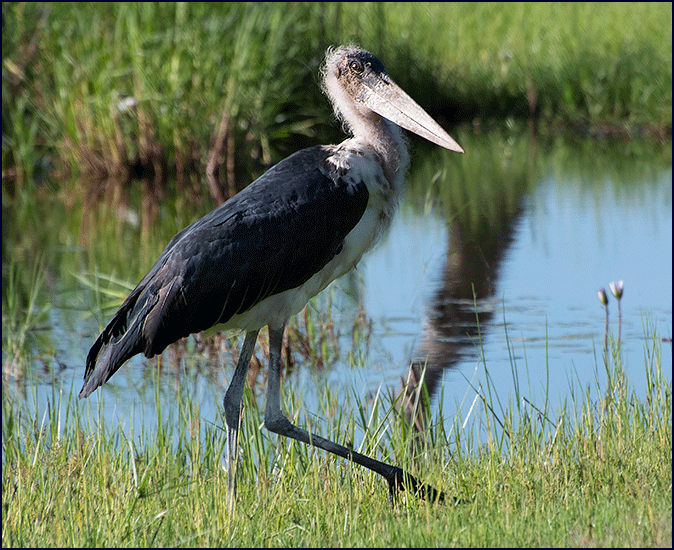
Marabou stork |
The first thing we encountered were a few Marabou storks,
so unattractive that it is hard to look away. Amur falcons and
red-necked falcons were flying overhead. We came upon a dead
elephant carcass, and then shortly two more; I found them very
distressing to see. Gee said they died in a drought during the dry
season; they had stayed in the Depression for the good food
sources, but the water had all dried up and they were not able to
make it to the Delta.
|
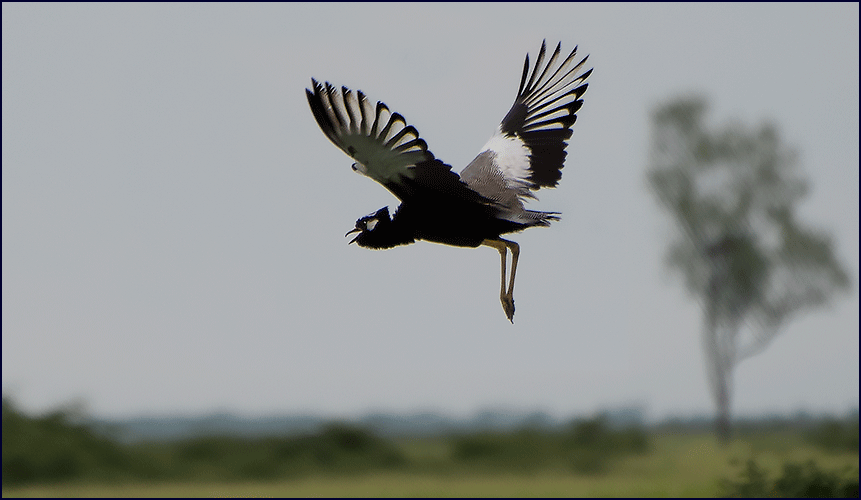
Northern black korhaan
|
A black-chested snake eagle took off from a treetop and
sailed overhead. We supposed he must be hunting for black-chested
snakes? A pair of tawny eagles perched in one tree, and a
Wahlberg's eagle in
another. A bit further
on we saw a red-necked falcon on the left side of a tree and a
red-footed falcon on the right - hard to keep them straight. A
northern black korhaan put on an amazing courtship display; the
black and white pheasant-sized bird flew straight up into the air
and the dropped like a rock, spinning, and squawking the whole
time.
Now we were starting to see animals. A few impala, several
wildebeests, a kudu in the distance. Before long we came across a
pair of elegant giraffes; as always we were enchanted by them –
but because of being so behind schedule we could not linger.
As we drove on, we saw a family of very large warthogs; two
adults and three youngsters. They seemed huge; Gee confirmed that
the warthogs in the Depression tend to be bigger. We passed
several wildebeests with very small blond babies, with white
egrets following them. We drove by a huge bull elephant, and then
another.
A pair of tsessebes stood near the road, one of them with
his front feet up on a termite mound. Tsessebes are the fastest of
the antelopes, and they are built very uphill, with their front
legs longer than their hind, the opposite of the downhill-built
lechwe. They are interesting antelopes, quite large with dark
brown bodies, black faces, and short backwards-curving horns. And
they always seem to have their faces plastered with mud.
|
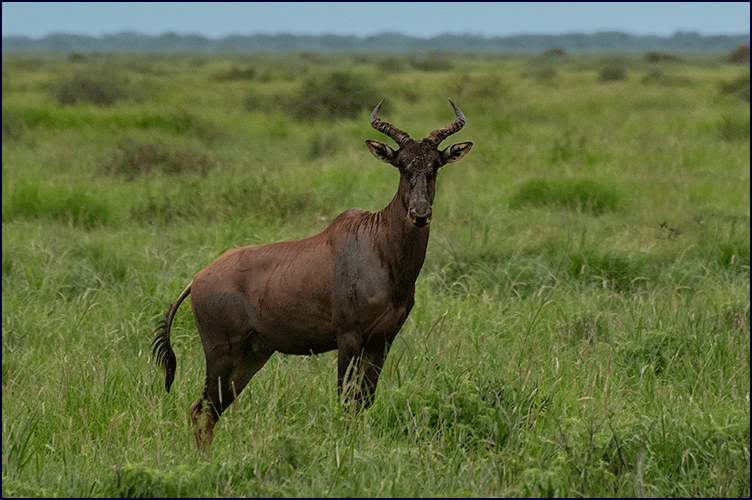
Tsessebe
|
A
group of fourteen ostriches were strolling along across the plain;
there were two black and white males, and the rest were the more
drab brown females. They started to run as a group, and it was
amazing to watch. Then suddenly they stopped and gathered
together, circling and shaking their wings and tail feathers,
bobbing up and down and side to side comically as they danced.
It was a little frustrating that we were having these great
wildlife sightings but could not spend time watching them because
of our deadline, but there was no choice - if we were going to
make Savuti camp by 6:30 we had to keep moving. But we did have to
stop once because we were losing a bed from the top of the
vehicle; fortunately Natalie noticed it in time and we were able
to shift everything back in place.
Presently the road took us into
scrubby mopane woodlands, leaving the Mababe Depression behind.
Twice a big bull elephant crossed the road just in front of us. We
had to stop again to reposition the shifting beds on the roof. We
heard distant thunder, and then not so distant – the storms were
all around us. Puddles, puddles everywhere, and the swoosh of the
waves beneath our tires.
Eventually we came to the Sand
Ridge; this slightly higher ground was the shore of the ancient
lake that formed the Depression. The sand was very deep; we could
see marks where bulldozers had scraped the road, but it didn’t
appear to help much. Being the rainy season the sand was wet and
reasonably firm, but clearly the deep sand of this road would be
much more difficult to navigate during the dry season. A lone
zebra plodded along the track.
We reached the Savuti area around 5.30. We passed the familiar
hills; big rocky outcrops jutting up out of the flat plain, also
known as kopjes. The first was Leopard Rock on the left, a place where we’d
had several memorable encounters with a leopardess in the past.
Then on the right was Bushman’s Rock, a huge kopje with a
massive baobab tree at its base. After that were Twin Hills on our
right, a pair of rocky outcroppings standing side by side. Then
Sable Hill on left, quite large, followed by a very round
outcropping on the right called Kudu Hill, and the last on our
route was Quarry Hill. Seeing these hills felt like coming home.
We had visited Savuti on our last trip and we had really missed
it; we were glad to be back.
We
arrived at our new camp at 6:25 pm, just making it in time before
the curfew. It was a nice location in the woods near the edge of
the Savuti Channel. We settled in to our tents and then headed for
dinner; it seemed a long time since those jungle oats at 5:30 that
morning!
~
Continued
on next page ~
Africa
2024 Pages:
1
2
3
4
5
6
7
8
9
10
11
12
Back
to the AFRICA 2024 INDEX Page
|